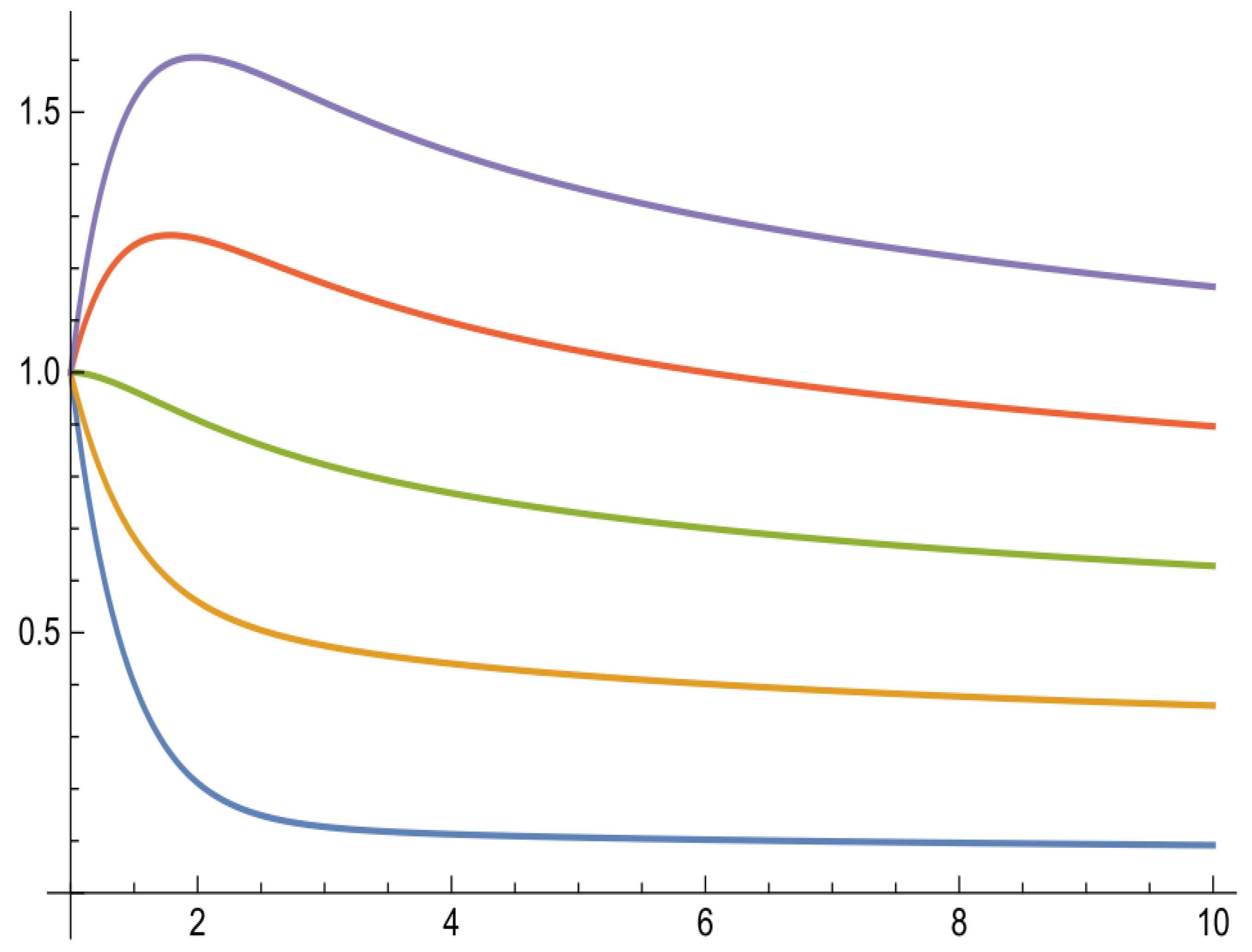Symmetric and Non-Oscillatory Characteristics of the Neutral Differential Equations Solutions Related to p-Laplacian Operators
Abstract
:1. Introduction
2. Non-Oscillatory Criteria
3. Conclusions
Author Contributions
Funding
Institutional Review Board Statement
Informed Consent Statement
Data Availability Statement
Acknowledgments
Conflicts of Interest
References
- Baculikova, B.; Dzurina, J. Oscillation theorems for second-order nonlinear neutral differential equations. Comput. Math. Appl. 2011, 62, 4472–4478. [Google Scholar] [CrossRef] [Green Version]
- Chatzarakis, G.E.; Li, T. Oscillations of differential equations generated by several deviating arguments. Adv. Differ. Equ. 2017, 2017, 292. [Google Scholar] [CrossRef]
- Bazighifan, O.; Dassios, I. Riccati Technique and Asymptotic Behavior of Fourth-Order Advanced Differential Equations. Mathematics 2020, 8, 590. [Google Scholar] [CrossRef] [Green Version]
- Chatzarakis, G.E.; Li, T. Oscillation criteria for delay and advanced differential equations with nonmonotone arguments. Complexity 2018, 2018, 8237634. [Google Scholar] [CrossRef] [Green Version]
- Elabbasy, E.M.; Cesarano, C.; Bazighifan, O.; Moaaz, O. Asymptotic and oscillatory behavior of solutions of a class of higher order differential equation. Symmetry 2019, 11, 1434. [Google Scholar] [CrossRef] [Green Version]
- Hale, J.K. Theory of Functional Differential Equations; Springer: New York, NY, USA, 1977. [Google Scholar]
- Li, T.; Han, Z.; Zhao, P.; Sun, S. Oscillation of even-order neutral delay differential equations. Adv. Differ. Equ. 2010, 2010, 763278. [Google Scholar] [CrossRef]
- Kiguradze, I.T.; Chanturiya, T.A. A Symptotic Properties of Solutions of Nonautonomous Ordinary Differential Equations; Kluwer Acad. Publ.: Dordrecht, The Netherlands, 1993. [Google Scholar]
- Agarwal, R.P.; Bazighifan, O.; Ragusa, M.A. Nonlinear Neutral Delay Differential Equations of Fourth-Order: Oscillation of Solutions. Entropy 2021, 23, 129. [Google Scholar] [CrossRef]
- Moaaz, O.; Elabbasy, E.M.; Muhib, A. Oscillation criteria for even-order neutral differential equations with distributed deviating arguments. Adv. Differ. Equ. 2019, 2019, 297. [Google Scholar] [CrossRef] [Green Version]
- Tang, S.; Li, T.; Thandapani, E. Oscillation of higher-order half-linear neutral differential equations. Demonstr. Math. 2013, 1, 101–109. [Google Scholar] [CrossRef]
- Xing, G.; Li, T.; Zhang, C. Oscillation of higher-order quasi linear neutral differential equations. Adv. Differ. Equ. 2011, 2011, 45. [Google Scholar] [CrossRef] [Green Version]
- Zafer, A. Oscillation criteria for even order neutral differential equations. Appl. Math. Lett. 1998, 11, 21–25. [Google Scholar] [CrossRef] [Green Version]
- Zhang, Q.; Yan, J. Oscillation behavior of even order neutral differential equations with variable coefficients. Appl. Math. Lett. 2006, 19, 1202–1206. [Google Scholar] [CrossRef] [Green Version]
- Roshid, H.O.; Ali, M.Z. Asymptotic Solutions of Fifth Order Overdamped-Oscillatory Nonlinear Systems. Contemp. Math. 2020, 1, 243–252. [Google Scholar]
- Roshid, H.O.; Noor, N.F.M.; Khatun, M.S.; Baskonus, H.M.; Belgacem, F.B.M. Breather, multi-shock waves and localized excitation structure solutions to the Extended BKP–Boussinesq equation. Commun. Nonlinear Sci. Numer. Simul. 2021, 101, 105867. [Google Scholar] [CrossRef]
- Li, T.; Baculikova, B.; Dzurina, J.; Zhang, C. Oscillation of fourth order neutral differential equations with p-Laplacian like operators. Bound. Value Probl. 2014, 2014, 56. [Google Scholar] [CrossRef] [Green Version]
- Zhang, C.; Agarwal, R.; Li, T. Oscillation and asymptotic behavior of higher-order delay differential equations with p-Laplacian like operators. J. Math. Anal. Appl. 2014, 409, 1093–1106. [Google Scholar] [CrossRef]
- Bazighifan, O. On the oscillation of certain fourth-order differential equations with p-Laplacian like operator. Appl. Math. Comput. 2020, 386, 125475. [Google Scholar] [CrossRef]
- Bazighifan, O.; Ghanim, F.; Awrejcewicz, J.; Al-Ghafri, K.S.; Al-Kandari, M. New Criteria for Oscillation of Half-Linear Differential Equations with p-Laplacian-like Operators. Mathematics 2021, 9, 2584. [Google Scholar] [CrossRef]
- Agarwal, R.P.; Bohner, M.; Li, T.; Zhang, C. A new approach in the study of oscillatory behavior of even-order neutral delay diferential equations. Appl. Math. Comput. 2013, 225, 787–794. [Google Scholar]
- Agarwal, R.; Grace, S.; O’Regan, D. Oscillation Theory for Difference and Functional Differential Equations; Kluwer Acad. Publ.: Dordrecht, The Netherlands, 2000. [Google Scholar]
- Bazighifan, O.; Almutairi, A.; Almarri, B.; Marin, M. An Oscillation Criterion of Nonlinear Differential Equations with Advanced Term. Symmetry 2021, 13, 843. [Google Scholar] [CrossRef]
- Philos, C.G. On the existence of nonoscillatory solutions tending to zero at ∞ for differential equations with positive delays. Arch. Math. 1981, 36, 168–178. [Google Scholar] [CrossRef]
- Agarwal, R.P.; Shieh, S.L.; Yeh, C.C. Oscillation criteria for second order retarded differential equations. Math. Comput. Model. 1997, 26, 1–11. [Google Scholar] [CrossRef]
- Bohner, M.; Grace, S.R.; Jadlovska, I. Oscillation criteria for second-order neutral delay differential equations. Electron. J. Qual. Theory Differ. Equ. 2017, 2017, 60. [Google Scholar] [CrossRef]
- Kitamura, Y.; Kusano, T. Oscillation of first-order nonlinear differential equations with deviating arguments. Proc. Am. Math. Soc. 1980, 78, 64–68. [Google Scholar] [CrossRef]

Publisher’s Note: MDPI stays neutral with regard to jurisdictional claims in published maps and institutional affiliations. |
© 2022 by the authors. Licensee MDPI, Basel, Switzerland. This article is an open access article distributed under the terms and conditions of the Creative Commons Attribution (CC BY) license (https://creativecommons.org/licenses/by/4.0/).
Share and Cite
Almarri, B.; Ali, A.H.; Al-Ghafri, K.S.; Almutairi, A.; Bazighifan, O.; Awrejcewicz, J. Symmetric and Non-Oscillatory Characteristics of the Neutral Differential Equations Solutions Related to p-Laplacian Operators. Symmetry 2022, 14, 566. https://doi.org/10.3390/sym14030566
Almarri B, Ali AH, Al-Ghafri KS, Almutairi A, Bazighifan O, Awrejcewicz J. Symmetric and Non-Oscillatory Characteristics of the Neutral Differential Equations Solutions Related to p-Laplacian Operators. Symmetry. 2022; 14(3):566. https://doi.org/10.3390/sym14030566
Chicago/Turabian StyleAlmarri, Barakah, Ali Hasan Ali, Khalil S. Al-Ghafri, Alanoud Almutairi, Omar Bazighifan, and Jan Awrejcewicz. 2022. "Symmetric and Non-Oscillatory Characteristics of the Neutral Differential Equations Solutions Related to p-Laplacian Operators" Symmetry 14, no. 3: 566. https://doi.org/10.3390/sym14030566
APA StyleAlmarri, B., Ali, A. H., Al-Ghafri, K. S., Almutairi, A., Bazighifan, O., & Awrejcewicz, J. (2022). Symmetric and Non-Oscillatory Characteristics of the Neutral Differential Equations Solutions Related to p-Laplacian Operators. Symmetry, 14(3), 566. https://doi.org/10.3390/sym14030566







